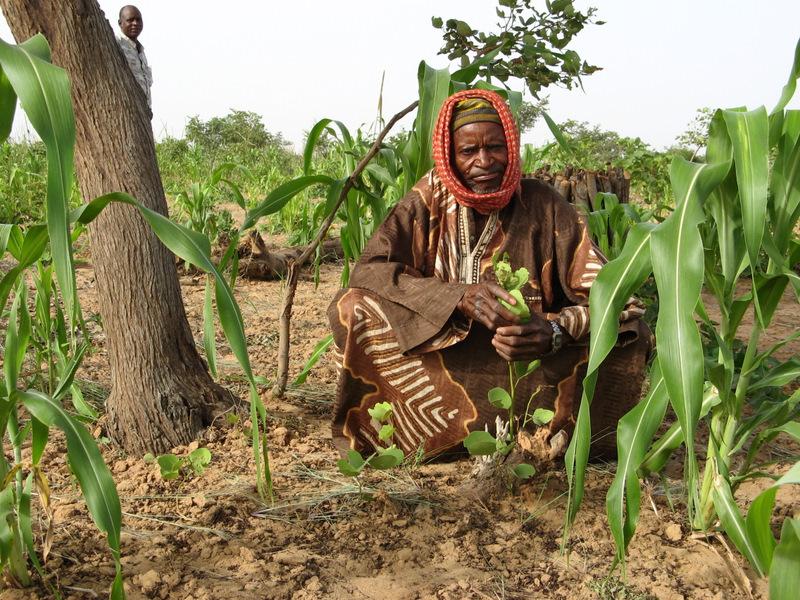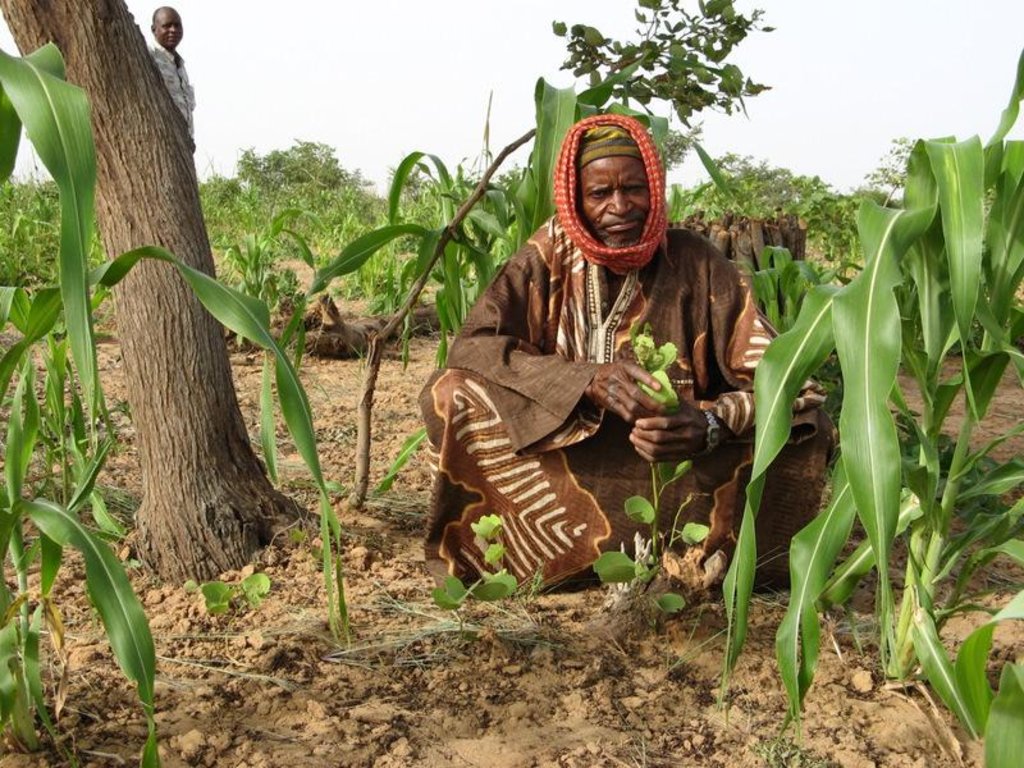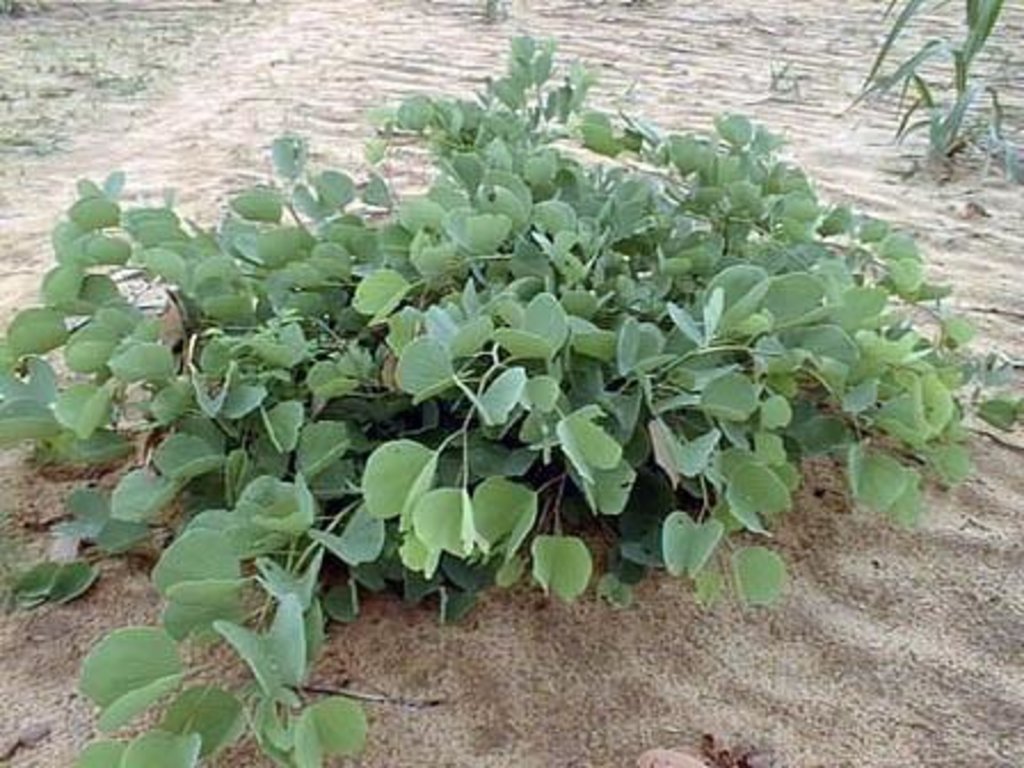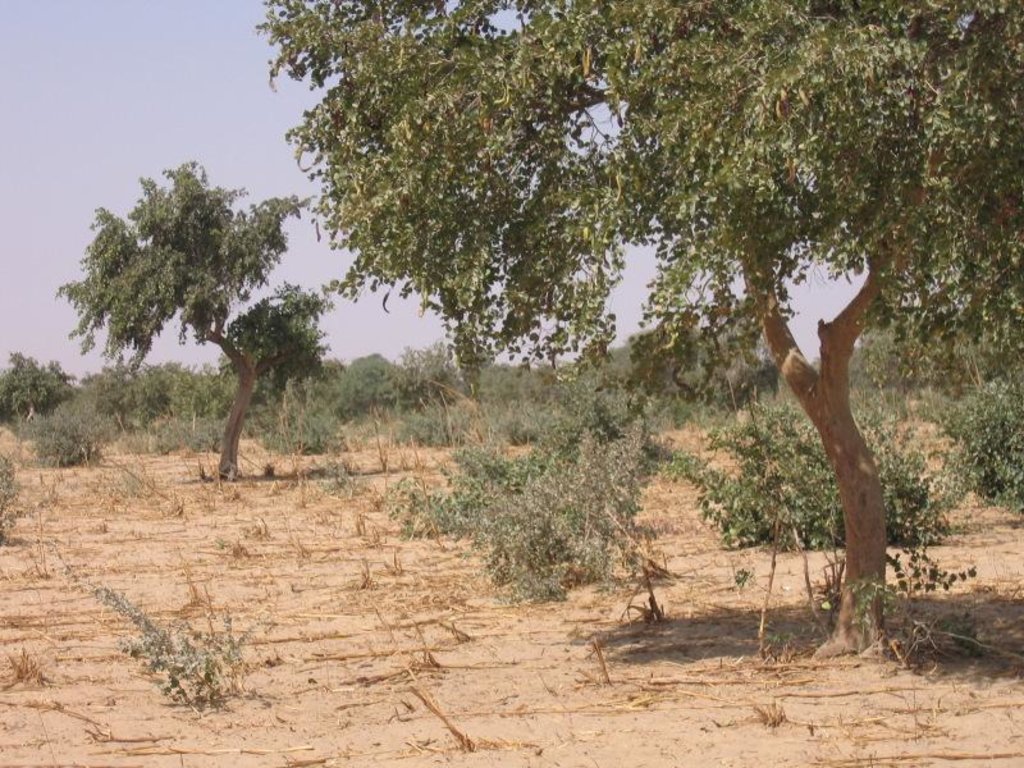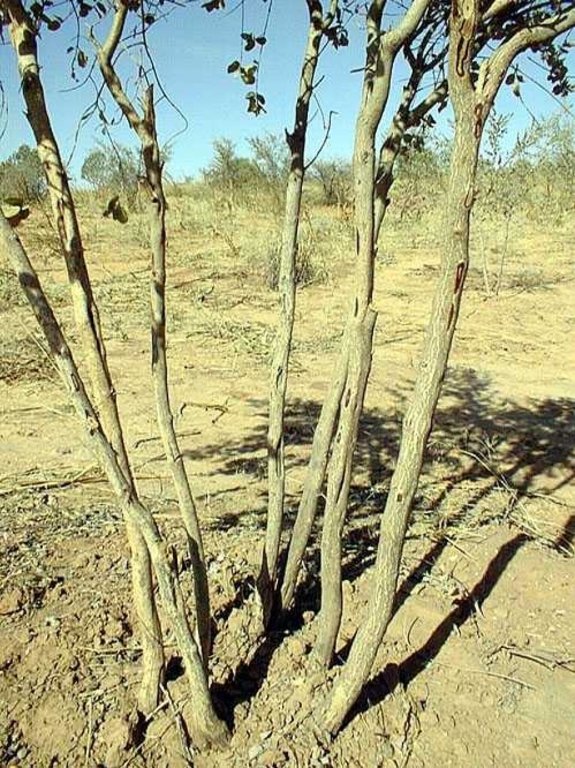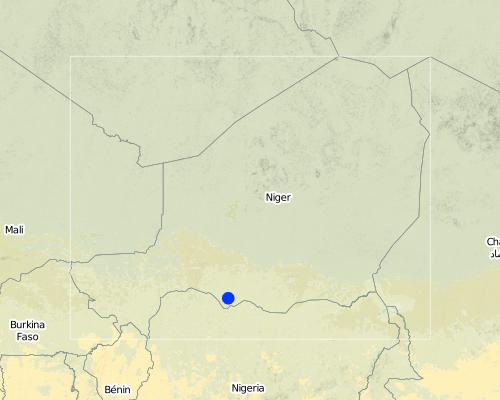Farmer Managed Natural Regeneration [Niger]
- Creation:
- Update:
- Compiler: Unknown User
- Editor: –
- Reviewer: David Streiff
technologies_1340 - Niger
View sections
Expand all Collapse all1. General information
1.2 Contact details of resource persons and institutions involved in the assessment and documentation of the Technology
Key resource person(s)
SLM specialist:
Rinaudo Tony
tonyrinaudo@worldvision.com.au
World Vision
Melbourne
Australia
SLM specialist:
Pasternak Dov
d.pasternak@icrisatne.ne
ICRISAT
Niamey, Niger
Netherlands
Name of the institution(s) which facilitated the documentation/ evaluation of the Technology (if relevant)
ICRISAT International Crops Research Institute for the Semi-Arid Tropics (ICRISAT) - NigerName of the institution(s) which facilitated the documentation/ evaluation of the Technology (if relevant)
World Vision (World Vision) - Switzerland1.3 Conditions regarding the use of data documented through WOCAT
The compiler and key resource person(s) accept the conditions regarding the use of data documented through WOCAT:
Ja
2. Description of the SLM Technology
2.1 Short description of the Technology
Definition of the Technology:
FMNR is the systematic regeneration of living and sprouting stumps of indigenous vegetation which used to be slashed and burned in traditional field preparation.
2.2 Detailed description of the Technology
Description:
The naturally occurring seedlings and/or sprouts are managed and protected by local farmers. Most suitable are species with deep roots that do not compete with crops and have good growth performance even during poor rainy seasons. In the case study area the three most valuable species – as perceived by land users – are Faidherbia albida; Piliostigma reticulatum and Guiera senegalensis.
Purpose of the Technology: This option allows idle land to become a productive resource during an otherwise unproductive eight-month dry season.
Establishment / maintenance activities and inputs: The ideal density, when grown with cereal crops, is between 50 and 100 trees per hectare. For each stump, the tallest and straightest stems are selected and side branches removed to roughly half of the stem height. Excess shoots are then removed. Regular pruning of any unwanted new stems and side branches stimulates growth rates. Farmers are encouraged to leave 5 stems / shoots per tree, cutting one stem each year and letting another grow in its place. On removing a shoot, the cut leaves are left on the surface where they reduce erosion and are then eaten by termites, returning the nutrients to the soil. The remaining shoots continue to grow, providing a continuous supply of wood. From the first year, firewood is collected from trimmings. From the second year on, cut branches are thick enough to sell. A more intensive form of FMNR is to profit from every stump sprouting on the land.
Natural / human environment: FMNR is a simple, low-cost and multi-benefit method of re-vegetation, accessible to all farmers, and adapted to the needs of smallholders. It reduces dependency on external inputs, is easy to practice and provides multiple benefits to people, livestock, crops and the environment. Tree layout will need to be carefully considered if ploughs are used for cultivation.
2.3 Photos of the Technology
2.5 Country/ region/ locations where the Technology has been applied and which are covered by this assessment
Country:
Niger
Further specification of location:
Maradi
Map
×2.6 Date of implementation
If precise year is not known, indicate approximate date:
- 10-50 years ago
2.7 Introduction of the Technology
Specify how the Technology was introduced:
- through land users' innovation
Comments (type of project, etc.):
early 1980's
3. Classification of the SLM Technology
3.1 Main purpose(s) of the Technology
- improve production
3.2 Current land use type(s) where the Technology is applied

Cropland
- Annual cropping
Comments:
Major land use problems (land users’ perception): Deforestation, Wind erosion, Water deficiency, Movement of sand dunes
Future (final) land use (after implementation of SLM Technology): Mixed: Mf: Agroforestry
If land use has changed due to the implementation of the Technology, indicate land use before implementation of the Technology:
Cropland: Ca: Annual cropping
3.3 Further information about land use
Water supply for the land on which the Technology is applied:
- rainfed
3.4 SLM group to which the Technology belongs
- natural and semi-natural forest management
3.5 Spread of the Technology
Specify the spread of the Technology:
- evenly spread over an area
If the Technology is evenly spread over an area, indicate approximate area covered:
- > 10,000 km2
Comments:
Total area covered by the SLM Technology is 50000 km2.
3.6 SLM measures comprising the Technology

vegetative measures
- V1: Tree and shrub cover

management measures
- M1: Change of land use type
Comments:
Type of vegetative measures: scattered / dispersed
3.7 Main types of land degradation addressed by the Technology

soil erosion by wind
- Et: loss of topsoil
- Ed: deflation and deposition

biological degradation
- Bc: reduction of vegetation cover
- Bq: quantity/ biomass decline
- Bs: quality and species composition/ diversity decline

water degradation
- Ha: aridification
Comments:
Secondary types of degradation addressed: Bs: quality and species composition /diversity decline, Ha: aridification
3.8 Prevention, reduction, or restoration of land degradation
Specify the goal of the Technology with regard to land degradation:
- reduce land degradation
- restore/ rehabilitate severely degraded land
Comments:
Secondary goals: mitigation / reduction of land degradation
4. Technical specifications, implementation activities, inputs, and costs
4.2 Technical specifications/ explanations of technical drawing
Technical knowledge required for field staff / advisors: moderate
Technical knowledge required for land users: moderate
Main technical functions: increase in organic matter, increase in nutrient availability (supply, recycling,…), reduction in wind speed, increase of biomass (quantity), promotion of vegetation species and varieties (quality, eg palatable fodder)
Secondary technical functions: control of raindrop splash, increase of infiltration
Scattered / dispersed
Vegetative material: T : trees / shrubs
Number of plants per (ha): 50
Trees/ shrubs species: Faidherbia albida, Piliostigma reticulatum, Guiera senegalensis
4.3 General information regarding the calculation of inputs and costs
Specify currency used for cost calculations:
- US Dollars
4.4 Establishment activities
| Activity | Type of measure | Timing | |
|---|---|---|---|
| 1. | Select 50 - 100 stumps per hectare for regrowth during the dry season | Vegetative | dry season |
| 2. | Select the tallest and straightest stems and prune side branches to roughly half the height of the stem (using sharpened axe or machete and cutting upwards carefully) | Vegetative | |
| 3. | Remove excess shoots, leave the cut leaves on the surface | Vegetative | |
| 4. | Prune any unwanted new stems and side branches (each 2-6 months) | Vegetative |
4.5 Costs and inputs needed for establishment
| Specify input | Unit | Quantity | Costs per Unit | Total costs per input | % of costs borne by land users | |
|---|---|---|---|---|---|---|
| Labour | Labour | ha | 1.0 | 6.0 | 6.0 | 100.0 |
| Total costs for establishment of the Technology | 6.0 | |||||
4.6 Maintenance/ recurrent activities
| Activity | Type of measure | Timing/ frequency | |
|---|---|---|---|
| 1. | Cut one stem (per tree) each year and let another grow in its place | Vegetative | |
| 2. | Once the stems selected for growth are > 2 meters high, they can be pruned up to two thirds | Vegetative | |
| 3. | Prune any unwanted new stems and side branches (each 2-6 months) | Vegetative |
4.7 Costs and inputs needed for maintenance/ recurrent activities (per year)
| Specify input | Unit | Quantity | Costs per Unit | Total costs per input | % of costs borne by land users | |
|---|---|---|---|---|---|---|
| Labour | Labour | ha | 1.0 | 4.0 | 4.0 | 100.0 |
| Total costs for maintenance of the Technology | 4.0 | |||||
Comments:
Machinery/ tools: All activities carried out manually
Annual income from selling wood: US$ 140 (from the 6th year after implementation). By some estimates, total benefit per hectare (incl. wood sales, increased crop yield, increased livestock productivity, wild foods and medicines etc) are in the order of US$ 200/ha, compared to an investment in labour US$ 10-15.
4.8 Most important factors affecting the costs
Describe the most determinate factors affecting the costs:
Main costs are in the form of labour. One man could prepare one hectare in 1–3 days, depending on tree density (labour is undertaken by the farm owner and rarely through paid labour). No inputs used; no extra tools needed, tools are available on-farm (hoe, axe, machete etc). Maintenance costs depend on tree density also and could require 1–2 days/year/ha.
5. Natural and human environment
5.1 Climate
Annual rainfall
- < 250 mm
- 251-500 mm
- 501-750 mm
- 751-1,000 mm
- 1,001-1,500 mm
- 1,501-2,000 mm
- 2,001-3,000 mm
- 3,001-4,000 mm
- > 4,000 mm
Agro-climatic zone
- semi-arid
Thermal climate class: tropics
5.2 Topography
Slopes on average:
- flat (0-2%)
- gentle (3-5%)
- moderate (6-10%)
- rolling (11-15%)
- hilly (16-30%)
- steep (31-60%)
- very steep (>60%)
Landforms:
- plateau/plains
- ridges
- mountain slopes
- hill slopes
- footslopes
- valley floors
Altitudinal zone:
- 0-100 m a.s.l.
- 101-500 m a.s.l.
- 501-1,000 m a.s.l.
- 1,001-1,500 m a.s.l.
- 1,501-2,000 m a.s.l.
- 2,001-2,500 m a.s.l.
- 2,501-3,000 m a.s.l.
- 3,001-4,000 m a.s.l.
- > 4,000 m a.s.l.
Comments and further specifications on topography:
Altitudinal zone: 200-300 m a.s.l.
5.3 Soils
Soil depth on average:
- very shallow (0-20 cm)
- shallow (21-50 cm)
- moderately deep (51-80 cm)
- deep (81-120 cm)
- very deep (> 120 cm)
Topsoil organic matter:
- low (<1%)
If available, attach full soil description or specify the available information, e.g. soil type, soil PH/ acidity, Cation Exchange Capacity, nitrogen, salinity etc.
Soil fertility is low
Soil drainage / infiltration is poor
5.6 Characteristics of land users applying the Technology
Market orientation of production system:
- mixed (subsistence/ commercial
Relative level of wealth:
- very poor
- poor
Individuals or groups:
- individual/ household
Level of mechanization:
- manual work
Indicate other relevant characteristics of the land users:
Land users applying the Technology are mainly disadvantaged land users
Population density: 10-50 persons/km2
5.7 Average area of land owned or leased by land users applying the Technology
- < 0.5 ha
- 0.5-1 ha
- 1-2 ha
- 2-5 ha
- 5-15 ha
- 15-50 ha
- 50-100 ha
- 100-500 ha
- 500-1,000 ha
- 1,000-10,000 ha
- > 10,000 ha
Is this considered small-, medium- or large-scale (referring to local context)?
- small-scale
5.8 Land ownership, land use rights, and water use rights
Land ownership:
- individual, not titled
Land use rights:
- individual
6. Impacts and concluding statements
6.1 On-site impacts the Technology has shown
Socio-economic impacts
Production
crop production
Comments/ specify:
At least doubled
animal production
Comments/ specify:
Nutritious pods as fodder
wood production
Comments/ specify:
Production value increased by 57%
Income and costs
farm income
workload
Comments/ specify:
Annual clearing and burning of tree stems (for land preparation) is not necessary any more
Socio-cultural impacts
food security/ self-sufficiency
Comments/ specify:
Edible leaves/fruits; bridge food shortages
quality of life
Comments/ specify:
Reduced wind speeds and dust; shade is available; barren landscape is returning to a natural savannah
disaster risk reduction
Comments/ specify:
FMNR acts as an insurance policy
livelihood and human well-being
Ecological impacts
Soil
soil cover
Quantity before SLM:
30
Quantity after SLM:
45
Comments/ specify:
trees / ha
Increased tree density on farmland
nutrient cycling/ recharge
Comments/ specify:
Dung; livestock spends more time in fields with trees
soil organic matter/ below ground C
Comments/ specify:
From leaf fall and trimmings
Biodiversity: vegetation, animals
biomass/ above ground C
plant diversity
beneficial species
habitat diversity
Comments/ specify:
Creation of habitat, food and shelter for predators of crop pests
pest/ disease control
Climate and disaster risk reduction
drought impacts
Comments/ specify:
Regenerated trees are indigenous and generally have mature root systems
wind velocity
Comments/ specify:
Resulting in greater deposition of rich, wind blown silt; improved micro-climate
6.2 Off-site impacts the Technology has shown
Urban populations benefit from cheaper, sustained wood supply and reduced incidence of dust storms
6.3 Exposure and sensitivity of the Technology to gradual climate change and climate-related extremes/ disasters (as perceived by land users)
Gradual climate change
Gradual climate change
| Season | Type of climatic change/ extreme | How does the Technology cope with it? | |
|---|---|---|---|
| annual temperature | increase | well |
Climate-related extremes (disasters)
Meteorological disasters
| How does the Technology cope with it? | |
|---|---|
| local rainstorm | well |
| local windstorm | well |
Climatological disasters
| How does the Technology cope with it? | |
|---|---|
| drought | well |
6.4 Cost-benefit analysis
How do the benefits compare with the establishment costs (from land users’ perspective)?
Short-term returns:
positive
Long-term returns:
very positive
How do the benefits compare with the maintenance/ recurrent costs (from land users' perspective)?
Short-term returns:
positive
Long-term returns:
very positive
Comments:
Annual income from selling wood: US$ 140 (from the 6th year after implementation).
6.5 Adoption of the Technology
- more than 50%
Of all those who have adopted the Technology, how many have did so spontaneously, i.e. without receiving any material incentives/ payments?
- 90-100%
Comments:
Comments on spontaneous adoption: Spread has been largely spontaneous, with minimal external assistance. The area covered today by trees from FMNR is estimated to be more than 50,000 km2 in Niger.
6.7 Strengths/ advantages/ opportunities of the Technology
| Strengths/ advantages/ opportunities in the compiler’s or other key resource person’s view |
|---|
| FMNR is a simple, low-cost and multi-benefit method of re-vegetation, accessible to all farmers, and adapted to the needs of smallholders |
| It reduces dependency on external inputs, is easy to practice and provides multiple benefits to people, livestock, crops and the environment |
6.8 Weaknesses/ disadvantages/ risks of the Technology and ways of overcoming them
| Weaknesses/ disadvantages/ risks in the compiler’s or other key resource person’s view | How can they be overcome? |
|---|---|
| Scarce presence of live tree stumps | alternatively broadcast seeds of indigenous species (reduced short-term benefits; high mortality rates) |
| Cultural norms and values: ‘a good farmer is a clean farmer’ (= no trees) | work with all stakeholders to change norms |
| Land (including trees) is treated as common property during dry season; damaging and removing trees on other people’s land occurs | create sense of ownership of trees: (1) Encourage communities to develop rules that respect property; (2) Local forestry authorities granting informal approval for farmers to be able to reap the benefits of their work. |
7. References and links
7.2 References to available publications
Title, author, year, ISBN:
Rinaudo T (1999): Utilizing the Underground Forest: Farmer Managed Natural Regeneration of Trees, in Dov Pasternak and Arnold Schlissel (Eds). Combating Desrtification with Plants.
Title, author, year, ISBN:
Cunningham PJ and Abasse T (2005): Reforesting the Sahel: Farmer Managed Natural Regeneration; in Kalinganire A, Niang A and Kone A (2005). Domestication des especes agroforestieres au Sahel: situation actuelle et perspectives. ICRAF Working Paper, ICRAF, Nairobi.
Title, author, year, ISBN:
Haglund E, Ndjeunga J, Snook L, and Pasternak D (2009): Assessing the Impacts of Farmer Managed Natural Regeneration in the Sahel: A Case Study of Maradi Region, Niger (Draft Version)
Links and modules
Expand all Collapse allLinks
No links
Modules
No modules


